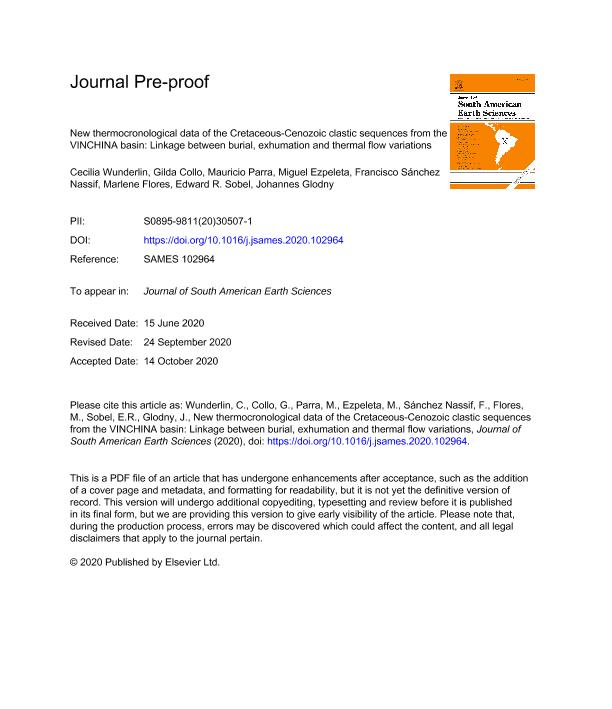Artículo
New thermocronological data of the Cretaceous-Cenozoic clastic sequences from the VINCHINA basin: Linkage between burial, exhumation and thermal flow variations
Wunderlin, Cecilia Ayelén ; Collo, Gilda
; Collo, Gilda ; Parra, Mauricio; Ezpeleta, Miguel
; Parra, Mauricio; Ezpeleta, Miguel ; Sánchez Nassif, Francisco Gabriel Antonio
; Sánchez Nassif, Francisco Gabriel Antonio ; Flores, Marlene; Sobel, Edward Robert; Glodny, Johannes
; Flores, Marlene; Sobel, Edward Robert; Glodny, Johannes
 ; Collo, Gilda
; Collo, Gilda ; Parra, Mauricio; Ezpeleta, Miguel
; Parra, Mauricio; Ezpeleta, Miguel ; Sánchez Nassif, Francisco Gabriel Antonio
; Sánchez Nassif, Francisco Gabriel Antonio ; Flores, Marlene; Sobel, Edward Robert; Glodny, Johannes
; Flores, Marlene; Sobel, Edward Robert; Glodny, Johannes
Fecha de publicación:
01/2021
Editorial:
Pergamon-Elsevier Science Ltd
Revista:
Journal of South American Earth Sciences
ISSN:
0895-9811
Idioma:
Inglés
Tipo de recurso:
Artículo publicado
Clasificación temática:
Resumen
New apatite fission track (AFT) and (U–Th)/He (AHe) data from two sections recording Cretaceous-Cenozoic clastic successions (La Flecha - La Troya Sur creeks) in the northern sector of the Central Precordillera of Argentina are presented. The results show that the Ciénaga del Río Huaco, Puesto la Flecha and Vallecito Fms. would have crossed the 60 °C isotherm during burial, while the middle sector of the Vinchina Fm. would not have reached temperatures higher than 55 °C. Multimethod inverse thermal modeling suggests that the AFT ages of all the studied levels would not have been completely reset and allow inferring that the partial retention zone for the AHe system (AHe-PRZ) would have been reached during the Miocene in levels between the Vallecito and Vinchina Fms. Our 1D-modeling results for the Ciénaga del Río Huaco, Puesto la Flecha and Vallecito Fms. show that the maximum temperature would have been reached at ~15 Ma, with a sedimentary thickness of ~2750 m and a heat flow of 65 mW/m2. From these data, a geothermal gradient of ~27 °C/km at this time could be inferred. In turn, the Vinchina and Zapallar Fms. would have reached their maximum temperature at ~2 Ma, under a cooler thermal regime (20 mW/m2) and with an estimated geothermal gradient of <15 °C/km. Thus, a complex time-temperature trajectory is proposed. Maximum and cooling temperatures reached by each unit do not correspond in all cases to the maximum burial and exhumation times. Comparison of the thermal modelling from this work with those carried out by other authors for sections immediately to the north allows us to infer that the thermal regime within the Vinchina basin has important lateral variations. Finally, AFT and AHe analyzes carried out in this work constitute a baseline database of the thermal regime, which is necessary for future multiproxies studies that are being done to evaluate the preservation of primary thermal signals, and thus check their reliability for pealeoclimatic and paleoenvironmental interpretations.
Archivos asociados
Licencia
Identificadores
Colecciones
Articulos(CICTERRA)
Articulos de CENTRO DE INVEST.EN CS.DE LA TIERRA
Articulos de CENTRO DE INVEST.EN CS.DE LA TIERRA
Citación
Wunderlin, Cecilia Ayelén; Collo, Gilda; Parra, Mauricio; Ezpeleta, Miguel; Sánchez Nassif, Francisco Gabriel Antonio; et al.; New thermocronological data of the Cretaceous-Cenozoic clastic sequences from the VINCHINA basin: Linkage between burial, exhumation and thermal flow variations; Pergamon-Elsevier Science Ltd; Journal of South American Earth Sciences; 105; 1-2021; 1-36; 102964
Compartir
Altmétricas



